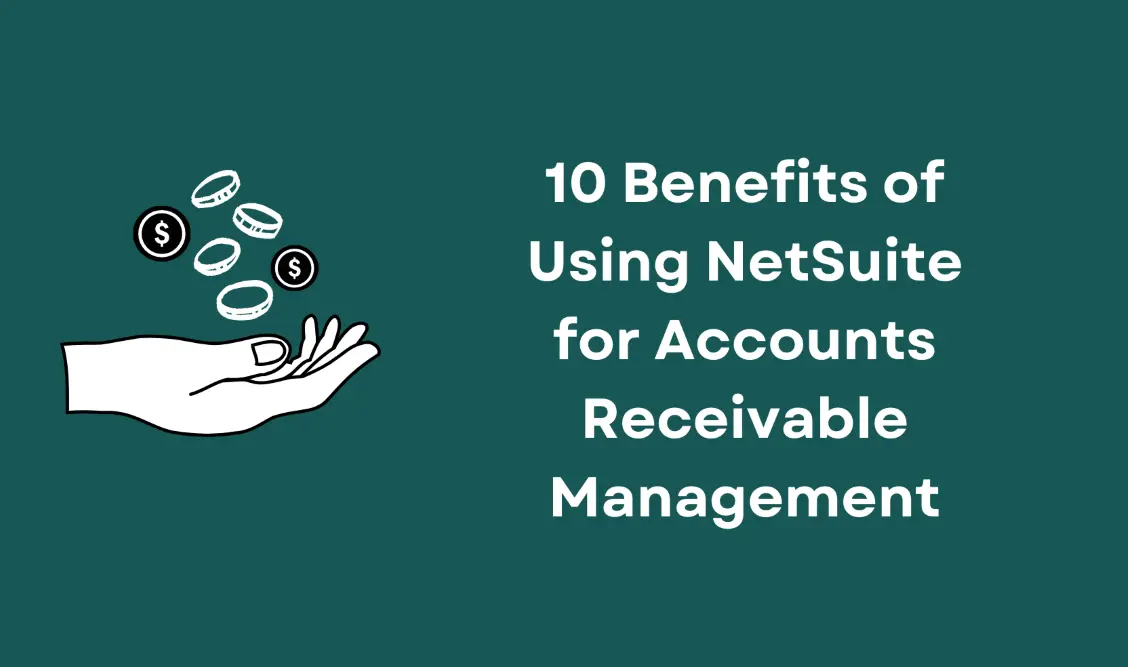
Managing accounts receivable is key to keeping your business financially healthy. This guide explores how NetSuite can simplify accounts receivable management. Learn the benefits and tips for optimizing your process with NetSuite’s tools.
What Is Accounts Receivable Management?
Accounts receivable management is the process of tracking and collecting payments from customers who owe money. Managing accounts receivable ensures that businesses receive the funds they are owed promptly. This process includes:
- Sending invoices,
- Following up on overdue payments,
- Recording payments received.
Proper accounts receivable management helps businesses maintain healthy cash flow, which is vital for day-to-day operations. Without managing accounts receivable effectively, companies might struggle to cover their expenses and could face financial difficulties. By focusing on managing accounts receivable, businesses can keep their finances in good shape.
NetSuite for Accounts Receivable Management: 10 Benefits
NetSuite is a cloud-based software that simplifies financial management. NetSuite Accounting offers tools to manage accounts receivable efficiently, helping businesses improve cash flow and control their finances. Now, let’s explore the specific benefits of using NetSuite for accounts receivable management.
1. Automated Invoicing
NetSuite Accounting helps automate invoicing, reducing the need for manual data entry. This feature ensures that invoices are sent out on time, improving cash flow and reducing errors. By using NetSuite Accounting, businesses can focus more on growth rather than paperwork.
2. Real-Time Payment Tracking
With NetSuite Accounting, businesses can track payments in real time. This feature allows them to see who has paid and who still owes money. Real-time tracking helps businesses stay on top of their finances without any guesswork.
3. Simplified Payment Collections
NetSuite Accounting simplifies the process of collecting payments. It offers easy-to-use tools to follow up on overdue payments, which helps businesses collect what they are owed more quickly. This simplicity makes it easier for companies to keep cash flowing.
4. Centralized Customer Records
NetSuite Accounting provides a centralized system for managing customer records. This system allows businesses to keep all customer information in one place, making it easy to track who owes what. A centralized record system saves time and reduces the chance of errors.
5. Customizable Reporting
NetSuite Accounting offers customizable reports that provide insights into accounts receivable. These reports help businesses understand their financial health and make informed decisions. By using NetSuite Accounting, companies can generate reports that meet their specific needs.
6. Automatic Reminders for Payments
With NetSuite Accounting, businesses can set up automatic reminders for payments. These reminders ensure that customers pay on time, which helps businesses avoid cash flow issues. Automated reminders take the burden off staff and improve payment collection rates.
7. Integration with Other Systems
NetSuite Accounting integrates smoothly with other business systems, such as CRM and ERP. This integration ensures that all financial data is consistent and up to date. Using NetSuite Accounting, businesses can avoid the hassle of managing multiple systems.
8. Improved Cash Flow Management
NetSuite Accounting improves cash flow management by providing tools to monitor incoming payments. Better cash flow management helps businesses pay their bills on time and invest in new opportunities. NetSuite Accounting makes it easier to keep track of every dollar.
9. User-Friendly Interface
NetSuite Accounting features a user-friendly interface that is easy to navigate. This simplicity allows even those with little accounting experience to manage accounts receivable effectively. A user-friendly system means less time spent on training and more time on growing the business.
10. Scalable Solutions for Growing Businesses
NetSuite Accounting offers scalable solutions that grow with your business. As your company expands, NetSuite Accounting can handle increased transaction volumes and complex financial needs. By choosing NetSuite Accounting, businesses can be confident that their accounting system will support their growth.
How to Optimize Accounts Receivable Automation with NetSuite?
The effective management of accounts receivable requires financial managers to use tools that simplify the process. One way to achieve this is to automate accounts receivable tasks with NetSuite. Here’s how you can optimize these features:
- Automate Invoicing: NetSuite can automatically send invoices to customers, reducing manual work.
- Track Payments Automatically: Set up NetSuite to monitor payments as they come in, ensuring nothing is missed.
- Follow Up on Overdue Accounts: Use automated reminders to prompt customers about overdue payments.
- Regularly Review Settings: Adjust your NetSuite settings as your business needs change to keep everything running smoothly.
By using NetSuite to automate accounts receivable, companies can reduce errors, save time, and improve cash flow. This makes the effective management of accounts receivable easier and more reliable.
Accounts Receivable Management Services of Hundred MS
At Hundred MS, we offer accounts receivable management services that help businesses keep their finances in order. Our specialists are experienced in handling the full process, from invoicing to payment collection. We also provide NetSuite Consulting to help you get the most out of your NetSuite software.
By integrating NetSuite Accounting services with our expertise, we ensure your accounts receivable are managed efficiently and accurately. Whether you need help setting up your system or managing day-to-day tasks, our team is here to support you. Let us help you improve your cash flow and keep your business running smoothly.
If you are looking for an outsourced accounts receivable specialist, Hundred MS is here to provide expert support and reliable management services.
Conclusion
Effective accounts receivable management is key to keeping your business financially healthy. By focusing on accounts receivable management, you can ensure steady cash flow management and avoid potential financial issues. Whether you choose to manage it in-house or outsource the task, having a solid accounts receivable management process in place is essential. With the right tools and expertise, you can simplify this process and keep your business running smoothly.
FAQ
An example of accounts receivable is when a business sells products or services to a customer on credit. The customer receives the goods or services and agrees to pay the business at a later date. The amount owed by the customer is recorded as accounts receivable until it is paid.
An accounts receivable report template in Excel is a spreadsheet that helps you track money owed by customers. It typically includes columns for customer names, invoice numbers, due dates, and payment statuses. This template makes it easy to monitor who owes you money and when payments are due.
Accounts receivable is considered a debit in accounting. When a sale is made on credit, the amount is recorded as a debit in the accounts receivable account because it represents money that is owed to the business.
The most important aspect of managing AR is ensuring that payments are collected on time. Timely collections keep cash flow steady, which is crucial for covering business expenses and keeping operations running smoothly.




